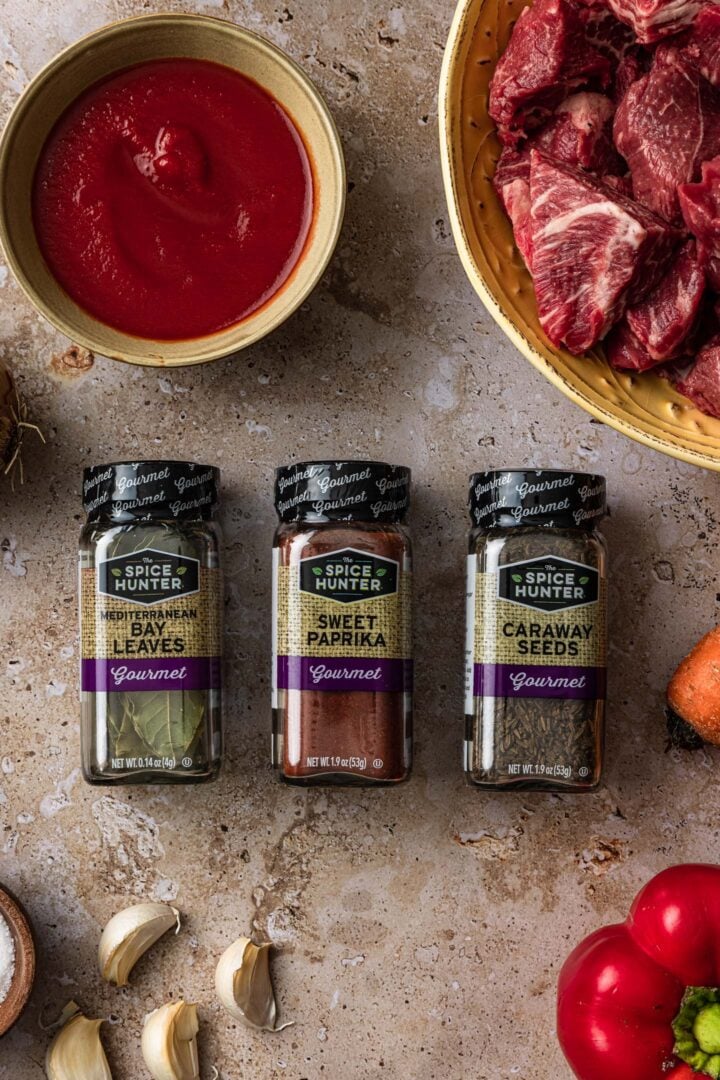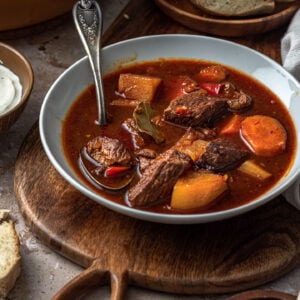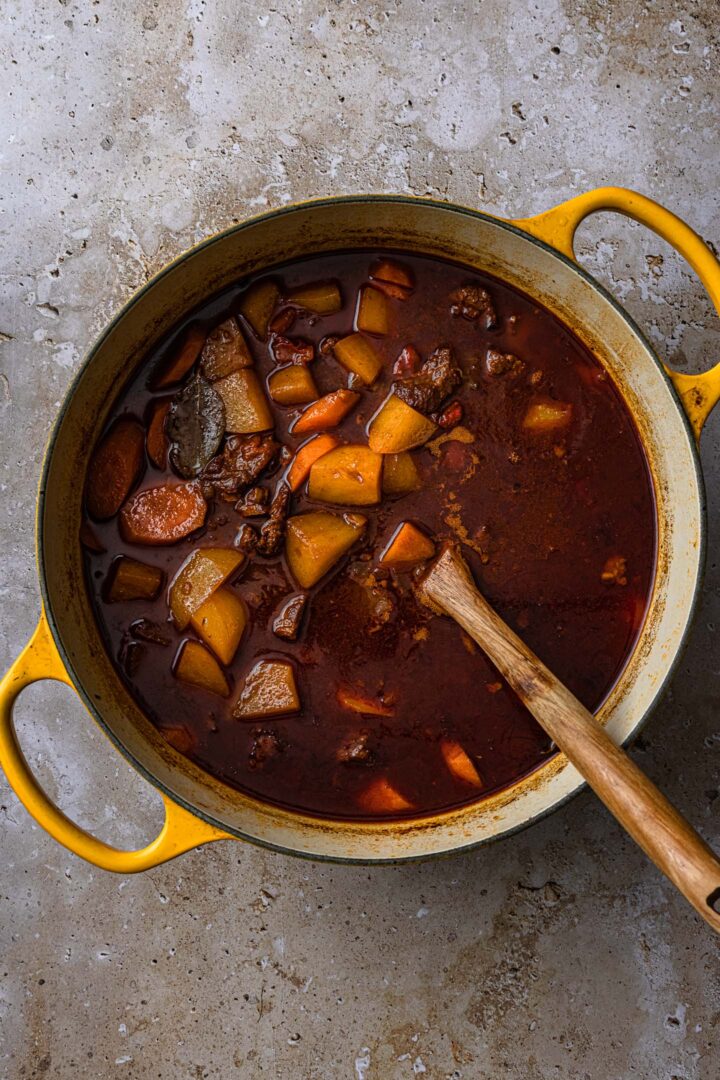Hungarian Goulash
Rich and hearty, Hungarian Goulash is a must-have during the chilly months! In this soup, chunky pieces of beef are flavored with lots of paprika and cooked low and slow in a flavorful broth until fall-apart tender. No wonder this deep red stew is considered Hungary’s national dish, it is truly a heart-warming meal.
While you can definitely cook the broth down to make Goulash more like a stew, it is traditionally served as a brothy soup. Check out my Pörkölt for the thick stew version of this dish!

This post is sponsored by The Spice Hunter® and includes tracking links. For more information about tracking links and how to opt out, please visit All About Do Not Track prior to clicking any links found in this post.
Soup weather is here and I couldn’t be happier!
Few things make me as giddy as a bowl of soup or stew on a cold day. And an authentic Goulash is one of my favorites, and a dish I like to have on rotation during fall and winter.
Now, I say “authentic” because the original recipe was given to me by a Hungarian neighbor when I lived in New York City. But I’ve tweaked the recipe so many times that I couldn’t possibly claim authenticity.
Authentic or not, this stick-to-your-ribs, soul-warming soup is something you absolutely must try now that temperatures are below 70! 🍂 🍁 🍂

What is Goulash?
Goulash, or Gulyás (pronounced GOO-yash) in Hungarian, is a traditional Hungarian soup-like stew, made of beef or pork and veggies flavored with lots of paprika. It is considered one of Hungary’s national dishes, but it’s eaten in other parts of Europe as well.
Its origins date back to the 9th century, when Hungarian Magyars shepherds who – before setting out with their sheep and cattle – would prepare this soup by cooking beef or mutton with onions and other long-lasting ingredients. They would then dry the stew out in the sun and pack into bags made of sheep’s stomach, that way they’d only need to add water to reconstitute it into a soup/stew.
The paprika, which is now an indispensable ingredient in goulash, was not included in the earlier versions of the recipe, as it was not introduced to the Old World until the 16th century.
Potatoes and bell peppers are also a modern (post-16th century) addition and unknown in the original recipe. Some purists claim that potatoes have no place in goulash, but to me they are a must! 😊
Hungarian Goulash VS American Goulash
The American version of goulash is a (almost unrecognizable) spin-off of the Hungarian recipe, but much simpler and quick to make. It involves ground beef, canned tomatoes or tomato sauce, macaroni or egg noodles, and sometimes cheese.
I’m not saying it isn’t delicious, but it’s a completely different beast, nothing like Hungarian Goulash and perhaps the subject of a future post!

Ingredients
To make this Goulash recipe, you will need:
- Beef – Any type of stew beef will do, but I do prefer the flavor and texture from a well-marbled chuck.
- Onions and Garlic – The flavor base! Goulash is traditionally quite onion-heavy.
- Veggies – You’ll need red bell peppers and celery.
- Roots – I use potatoes and carrots, but parsnips are also traditional!
- Paprika – In my opinion, sweet paprika is the star ingredient of this recipe. We’ll use quite a bit of it, so choose something high quality, such as The Spice Hunter Sweet Paprika.
- Caraway Seeds – Caraway seeds are a must in authentic beef goulash. They have a unique flavor profile that is nutty and bittersweet, with a hint of citrus, anise and pepper. A little goes a long way, so I only use 1/2 teaspoon of The Spice Hunter Whole Caraway Seeds (which I grind with a mortar and pestle).
- Bay Leaves – The Spice Hunter bay leaves add a slightly sweet, sort of tea-like note that enhances the other – bolder – flavors.
- Puréed Tomatoes – Tomato is not an ingredient in traditional goulash, not appearing in recipes until the first half of the 20th century. That being said, I think its sweetness compliments the other flavors in this stew perfectly, so don’t skip it!
- Fat – Traditionally, goulash is made with lard, but since I very rarely have it on hand, I use vegetable oil instead.
- Broth – You can use beef stock or beef broth. Chicken broth works too, in a pinch.
- Salt and Pepper


What is the Best Paprika for Goulash?
Sweet paprika is the ingredient that gives goulash its distinctive warm flavor and reddish color!
Since it’s such an important flavor here, you must make sure you are using fresh, good-quality paprika. Paprika does last a long time, but – as is the case with all spices – it does lose potency with time. So if your jar is older than a year, I’d definitely get a new one to make this recipe.
One of my favorites is the Ground Sweet Paprika from my friends at The Spice Hunter, which is natural and kosher certified. Its mild, sweet flavor is a great addition to this goulash and many other savory recipes.
I also got the bay leaves, caraway seeds and black pepper used in this recipe from The Spice Hunter, as well as several of the spices I have in my arsenal! ♥️
Note: The folks at The Spice Hunter were kind enough to offer our readers a special 20% discount! Use the code OLIVIA20 or shop here.

How to Make Goulash
There is no secret in making goulash. It is just like making any other stew!
My preferred method is cooking it low and slow on the stove, in a Dutch oven. However, this recipe is easily adaptable for the Instant Pot (if you need to cook faster) or Slow Cooker (if you want to be able to step away and come back to a hearty dinner).
As I mentioned earlier, I like using chuck beef for this recipe. If you choose to use a leaner cut, such as bottom or top round, be aware that the meat will cook faster!
Recommended tools and equipment: Dutch oven, wooden spoon.
Here’s how I make this goulash recipe. As always, you will find the printable (and more complete) version of the recipe at the end of this post!
Step 1: Brown the beef.
- Season the beef generously with salt and pepper.
- Heat the oil in a large Dutch oven and brown the beef. You should work in batches so as not to overcrowd the pot, that way the beef has a chance to brown properly and leave those delicious browned bits at the bottom of the pan (did you know they’re are called “fond”?) that will impart a lot of flavor to this soup.
- Remove the beef and reserve.
Step 2: Sauté the veggies.
- Sauté the onions, celery, red bell peppers and garlic. The moisture from the onions will help deglaze the bottom of the pot, but you could also use a small amount of red or white wine.
Step 3: Cook the beef.
- Add the paprika and let it cook for a few seconds to release its aroma. Be careful not to burn it! Paprika can burn quickly and will get bitter.
- Pour in the broth and tomato sauce, and add the caraway seeds, bay leaves, and a pinch of salt and pepper.
- Bring to a boil, then cover and simmer for 1 to 1 1/2 hours, or until the beef is tender but not quite falling apart.
Step 4: Cook the root vegetables.
- Add the potatoes and carrots, then cover and continue cooking until they are fork tender and the beef practically falls apart when you cut into it!
- Taste and adjust seasoning as needed, then serve with sour cream.
Olivia’s Tips
- I recommend adding the root vegetables only at the last 30 minutes of cooking time. That way they’ll be cooked but won’t turn into mush!
- Lightly heating the paprika before adding the liquid ingredients helps it to fully release flavor and aroma.
- A true goulash is not thickened with flour. It has the consistency of a soup, and not a thickened stew. If you’re after the latter, check out my recipe for Porkolt!
- If you like spicy food, you may add a pinch of cayenne pepper. Hot paprika is never added to goulash, but may be served at the table.
- Some people like to add a splash of vinegar at the end to brighten up the flavors!

What to Serve with Goulash?
Goulash is traditionally served with a dollop of sour cream and a jar of hot paprika at the table. Some good crusty bread is also a great call and will soak up all the delicious broth that is left behind in the bowl.
Some Hungarians like to serve their goulash accompanied by csipetke, which are small, fingernail-sized, pinched noodles.
If you want to pair your goulash with wine, you can go with a high-acidity red, such as a Pinot Noir or a Zinfandel. If you can find it, a traditional Hungarial red – such as Kekfrankos or Kadarka – is also an option.
Variations
There are as many versions of goulash as there are cooks in Hungary! Each home cook has a recipe and they swear by its authenticity.
But there are a few known variations, and I thought I’d share them here with you.
- In Székely Gulyás, you don’t add any potatoes and you add sauerkraut and sour cream.
- In Mock Gulyás, also called Hamisgulyás, you substitute the beef for beef bones.
- Bean Gulyás is made with kidney beans instead of potatoes and caraway seeds.
- If you use sauerkraut and no pasta or potatoes, it is called Csángó Gulyás.
- Betyár Gulyás calls for smoked beef or smoked pork.
- In Likócsi Pork Gulyás, you will use pork and thin vermicelli. The broth is also flavored with lemon juice.
- Mutton Gulyás or Birkagulyás is made with mutton and red wine.
- Székely gulyás is a thicker and richer goulash, more like a stew than a soup. It is named after the Hungarian writer József Székely and is made with three kinds of meat.

Frequently Asked Questions
Yes, goulash can be made ahead of time and the flavors of the soup will only improve after a day or two in the fridge. However, I find that the root vegetables can get mushy if refrigerated and reheated, so I would add them when you plan on serving the soup.
Like with many other beef stews, goulash will keep in the fridge for up to 4-5 days.
Yes, but – again – skip adding the root vegetables and add them after you thaw and reheat the goulash.
It’s not traditional, but, yes – of course – you can! Needless to say that cooking times will change.

Goulash Soup
Ingredients
- 2 ½ pounds chuck roast, trimmed from excess fat and cut into 1-inch chunks
- Salt and The Spice Hunter Black Pepper, to taste
- 2 tablespoons vegetable oil
- 3 large onions, chopped or sliced
- 2 celery ribs, chopped
- 2 red bell peppers, diced
- 6 cloves garlic, minced
- 3 tablespoons The Spice Hunter Sweet Paprika
- ½ teaspoon The Spice Hunter Caraway Seeds, crushed or ground
- ½ cup tomato passata (pureed tomatoes)
- 3 The Spice Hunter Bay Leaves
- 6 cups beef broth
- 4 large Yukon Gold potatoes, peeled and cut into 1-inch cubes
- 2 large carrots, peeled and cut into 1-inch pieces
Instructions
- Season the beef chunks generously with salt and pepper.
- Heat the oil in a large Dutch Oven, over medium-high heat, and – working in batches, brown the beef on all sides, about 1-2 minutes per side. Remove to a plate and reserve.
- Lower the heat to medium. Add the onions and cook until translucent, 2-3 minutes. Then, stir in the celery and red bell peppers, cooking until softened, about 5 minutes. Finally, add the garlic and cook for a minute, until fragrant.
- Stir in the paprika and mix to combine, letting it cook for a few seconds so it can release its flavors and aroma.
- Pour in the beef broth and tomato sauce, and add the caraway seeds, bay leaves and a small pinch of salt and pepper. Return the beef and juices to the pot. Bring to a boil, then cover and lower the heat to a simmer. Simmer for 1 to 1 ½ hours or until the beef is tender but not eat falling apart when you cut into it with a fork.
- Stir in the potatoes and carrots, cover and continue cooking for 30 to 45 minutes, or until the root vegetables are tender and the beef is fall-apart tender. Add more broth if needed.
- Taste and add salt and pepper if needed.
- To serve, ladle into bowls and serve with a dollop of sour cream and some crusty bread!











3 Comments on “Hungarian Goulash”
Finally, a post about Goulah that isn’t American Chop Suey. I appreciate that you included different ways it is made there and some history. I also agree on the importance of tge paprika. While there’s various types of paprika I in Hungary I only use paprika from Hungary. The one most commonly used is sweeter. But again to keep it more authentic I only use Hungarian paprika. Very good though. I’ve had weeks of people posting pasta with ground beef, tomatoes, bell peppers and some garlic and calling it Goulash. 🤢
Truly appreciate the way you made this delicious recipe. Everything is so nicely described that really helped me. Looking forward for more such yummy recipes in future too.
Almast perfect recipe for an authentic goulash, congratulations, Olivia! However, it would be perfect if you’d use rather sweet green pepper (definitely not bell pepper, but cubanelle, or similar shape-taste) instead. We never cook it with red bell pepper as it gives the goulash different taste (surely not worse but different).